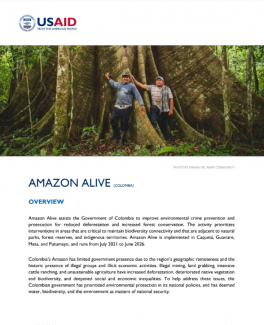OVERVIEW
Amazon Alive assists the Government of Colombia to improve environmental crime prevention and prosecution for reduced deforestation and increased forest conservation. The activity prioritizes interventions in areas that are critical to maintain biodiversity connectivity and that are adjacent to natural parks, forest reserves, and indigenous territories. Amazon Alive is implemented in Caquetá, Guaviare, Meta, and Putumayo, and runs from July 2021 to June 2026.
Colombia’s Amazon has limited government presence due to the region’s geographic remoteness and the historic presence of illegal groups and illicit economic activities. Illegal mining, land grabbing, intensive cattle ranching, and unsustainable agriculture have increased deforestation, deteriorated native vegetation and biodiversity, and deepened social and economic inequalities. To help address these issues, the Colombian government has prioritized environmental protection in its national policies, and has deemed water, biodiversity, and the environment as matters of national security.
GOALS
PREVENT AND PROSECUTE ENVIRONMENTAL CRIMES
Amazon Alive strengthens the Government of Colombia’s institutional capacity to prevent and prosecute environmental crimes, including its ability to disrupt the illegal activities that drive deforestation. The activity supports the creation and use of tools and data needed to respond to environmental crimes, and helps indigenous peoples, civil society organizations, and environmental defenders to understand, prevent, and denounce these crimes.
IMPROVE FOREST CONSERVATION AND MANAGEMENT
Amazon Alive strengthens land use rights, land tenure and access to land to improve land management and administration for forest conservation. The activity promotes market-based approaches and sustainable natural resources management practices that connect economic growth opportunities to conservation actions. These approaches contribute to reduced deforestation, biodiversity loss, and greenhouse gas (GHG) emissions. The activity helps indigenous peoples, civil society organizations, community action boards, and environmental leaders adopt innovative natural resource management practices, like the use of digital applications in forest management.
ANTICIPATED RESULTS
Reduce, sequester, and/or avoid the emission of 12 million metric tonnes of CO2;
Improve livelihood co-benefits for 10,850 people from environmentally sustainable practices;
Increase the number of formal charges against environmental crime offenders by 30 percent;
Mobilize USD $13.2 million in investment for biodiversity conservation and sustainable landscapes;
Improve natural resource management on 1.3 million hectares and biophysical conditions of 195 thousand hectares;
Strengthen 95 public institutions’ capacity to address environmental crimes, biodiversity loss, and climate change issues; and
Support the adoption and/or implementation of 50 laws, policies, strategies, plans, or regulations that address biodiversity conservation and/or other environmental themes.
| Contact Information |
|---|
| Jorge Martínez E-mail: jomartinez@amazoniamia.org |

